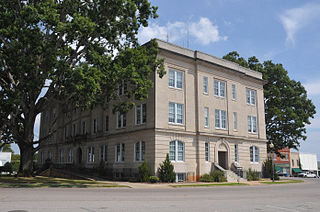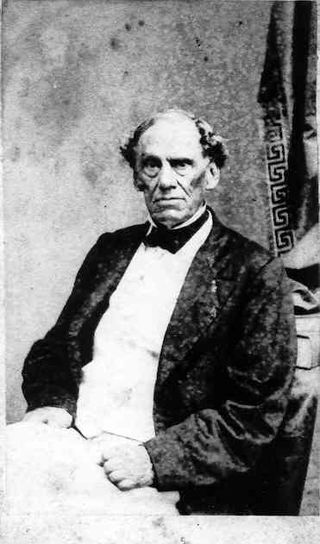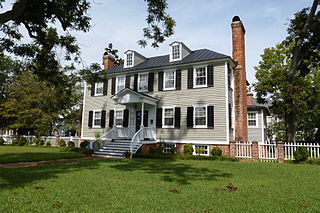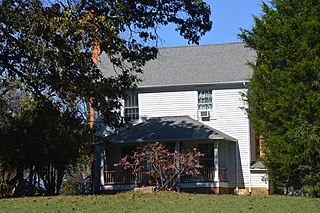
Carthage is the county seat of Moore County, North Carolina, United States. The population was 2,635 at the 2020 census. The city is named after Carthage.

Bedford Brown was a Democratic United States Senator from the State of North Carolina between 1829 and 1840.

This is a list of structures, sites, districts, and objects on the National Register of Historic Places in North Carolina:

Stagville Plantation is located in Durham County, North Carolina. With buildings constructed from the late 18th century to the mid-19th century, Stagville was part of one of the largest plantation complexes in the American South. The entire complex was owned by the Bennehan, Mantack and Cameron families; it comprised roughly 30,000 acres (120 km2) and was home to almost 900 enslaved African Americans in 1860.
The Harmony Plantation, also known as Montague-Jones Farm, is a historic plantation house located at 5104 Riley Hill Road near Wendell, North Carolina, a town in eastern Wake County. It was built in 1833, and is a two-story, three-bay, single-pile, Greek Revival style frame dwelling. It is sheathed in weatherboard, has a hipped roof, and a gabled rear ell. The front facade features a centered, double-tier pedimented, front-gabled portico with bracketed cornice and unfluted Doric order columns. Also on the property is a contributing one-story, rectangular, beaded weatherboard building that once housed a doctor's office (1833).
Charles T. Holt House is a historic home located at Haw River, Alamance County, North Carolina. It was designed by architect George Franklin Barber and built in 1897. The house is a 2+1⁄2-story, rectangular dwelling sheathed in wood, slate, brick and stone in the Queen Anne style. It features peaks, turrets and decorative chimney stacks. Also on the property are the contributing carriage house, servant's quarters, gas house, corn crib, barn, and well house. It was built for textile businessman Charles T Holt, the son of Thomas Michael Holt, governor of North Carolina, and his wife Gena Jones Holt, the daughter of Thomas Goode Jones, governor of Alabama.
Kelvin was a historic home located at Pittsboro, Chatham County, North Carolina. It was built about 1831, was a two-story, five bay Federal style single pile frame dwelling. The house had a gable roof and exterior end chimneys. It had a one-story addition built about 1838. It originally housed a private girls school established by wealthy landowner Colonel Edward Jones Kelvin. It has been demolished.

It was listed on the National Register of Historic Places in 2006.

Jones–Jarvis House, also known as General Foster's Headquarters and Jarvis–Slover House, is a historic home located at New Bern, Craven County, North Carolina. It was built about 1810, and is a 2+1⁄2-story, three-bay, side-hall plan, Federal-style brick dwelling. It has a one-story brick and frame rear wing. During the American Civil War, General John G. Foster moved into this house, and it served first as his residence and later as part of the headquarters of the Eighteenth Army Corps.

Tisdale–Jones House, also known as the New Bern City Schools Administration Building, is a historic home located at New Bern, Craven County, North Carolina. It was built about 1769, and is a 2+1⁄2-story, central hall plan frame dwelling with a large two-story rear ell. In 1958, the New Bern City Board of Education began using the building as offices; in the 1980s it was returned to private residential use.
Dr. Beverly Jones House is a historic plantation house located near Bethania, Forsyth County, North Carolina. It was designed by noted Virginia architect Dabney Cosby (1779-1862) and built in 1846–1847. It is a two-story, three bay by two bay, Neoclassical-style brick dwelling with a two-story rear wing. Also on the property are the contributing kitchen, smokehouse, and three slave houses.

Laurel Mill and Col. Jordan Jones House is a historic home and grist mill located near Gupton, Franklin County, North Carolina. The house was built about 1850, and is a one-story Greek Revival / Italianate style frame cottage over a raised brick basement. The frame mill building is two stories tall supported by large stone piers. The mill building extends over Sandy Creek. The house and mill are all that remains of the ambitious local industrial complex.
Jones–Wright House, also known as the Polly Wright House, is a historic plantation house located near Rocky Ford, Franklin County, North Carolina. It was built about 1790, and is a two-story, three-bay, single pile Late Georgian style heavy timber frame dwelling. It has a low gable roof and brick end chimneys.
Jesse Fuller Jones House is a historic plantation house in Spring Green, Martin County, North Carolina. It dates to the first quarter of the 19th century and is a 2+1⁄2-story, four-bay, Federal-style frame dwelling. It has a gable roof and flanking exterior end chimneys. The house features handsomely detailed interior woodwork. Also on the property is a contributing smokehouse.

Hamilton C. Jones III House, also known as The Stone House, is a historic home located at Charlotte, Mecklenburg County, North Carolina. It was built between 1929 and 1931, and is a massive, 2+1⁄2-story, four-bay, granite, Tudor Revival style dwelling. It is constructed of four-inch terra cotta tiles sheathed in ashlar granite, stucco, and half-timbering, and has a side-gable roof with dormers. It is a 1+1⁄2-story service ell. Also on the property is a contributing playhouse. It was the home of Congressman Hamilton C. Jones.

Holloway-Jones-Day House, also known as the Day House, is a historic home located near Roxboro, Person County, North Carolina. It was built about 1840, and is a two-story, Federal style frame farmhouse. A rear ell and hip roofed front porch with Italianate style decorative elements were added in the mid-19th century. It has brick gable end chimneys, front and rear transoms, a hall-parlor plan and a fieldstone cellar.

Jones–Lee House is a historic home located at Greenville, Pitt County, North Carolina, US. It was built in 1895, and is a two-story, "L"-plan, frame dwelling with Queen Anne style decorative elements. It has an intersecting gable roof and one-story, gable roofed porch. It features decorative shingles, curvilinear sawnwork, and applied half-timbering.

Rev. Joshua D. Jones House is a historic home located at Mill Spring, Polk County, North Carolina. It was built in 1897, and is a two-story, three-bay, frame I-house with a two-story rear ell. A kitchen addition was built in 1925. It features a shed-roofed porch covering three-fourths of the lower facade. Also on the property is the contributing one-room, frame store building and well. It was the home of African-American community leader Rev. Joshua D. Jones of the Stony Knoll community.

Nancy Jones House is a historic home located near Cary, Wake County, North Carolina. It was listed on the National Register of Historic Places in 1984. It is the oldest surviving structure in Cary.

Alpheus Jones House, also known as Seth Jones 1847 Restaurant, is a historic home located near Raleigh, Wake County, North Carolina. It was built in 1847, and is a two-story, rectangular, vernacular Greek Revival-style frame dwelling with a hipped roof. It is sheathed in weatherboard, sits on an ashlar foundation, and has a rear extension and kitchen wing. The front facade features a reconstructed two-story double Doric order portico. The house was restored in 1968, and renovated to house a restaurant.


















